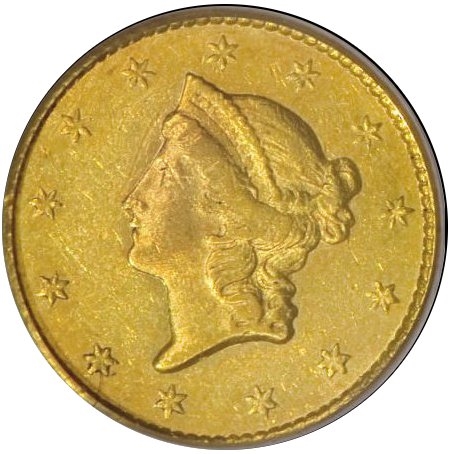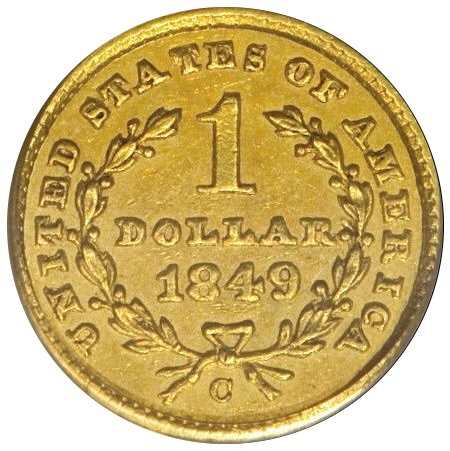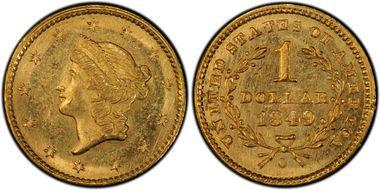Doug Winter
As far as most collectors are concerned, the 1849-C Closed wreath is the only variety of gold dollar from the Charlotte Mint dated 1849 that they can consider adding to their collection. While this is by far the more available of the two varieties, it is a scarce issue in its own right.
The 1849-C Closed Wreath gold dollar is most often seen in Very Fine and Extremely fine grades. This variety is scarce in About Uncirculated grades with most of the pieces in this range grading no better than AU50. The 1849-C Closed Wreath is very rare in Uncirculated with probably no more than a dozen known.
STRIKE: There are some reasonably well detailed examples but most show noticeable areas of weakness. The obverse is usually not fully defined on the hair below the coronet and around the ear. Much if this is due to the fact that the obverse fields appear to be very convex. This, in turn, not only tends to accentuate wear, but also makes them difficult to properly grade. I have seen 1849-C Closed Wreath gold dollars that looked as if they were considerably worn but that were, in fact, peculiarly struck. The reverse is always better struck than the obverse although most show weakness on the leaves at the left side of the wreath. The denticles from 5:00 to 8:00 are sometimes faint and may not be visible on some coins.
SURFACES: The obverse nearly always shows prominent abrasions. These marks are accentuated by the convex shape of the fields. Many are hairlined from having been cleaned and others show small, mint-made imperfections. It is exceptionally hard to locate an 1849-C Closed Wreath gold dollar with Choice surfaces.
LUSTER: The luster on most pieces is grainy and somewhat frosty in texture. There are a number that are either semi-prooflike or nearly fully prooflike on the obverse. The reverse is always more frosty and it lacks the depth of the reflectiveness seen on the obverse. The luster is often impaired due to repeated cleaning or dippings and any example with above-average luster is scarce and desirable.
COLORATION: Original, uncleaned pieces show very attractive deep yellow-gold or greenish-gold coloration. I have also seen a small number which have unusual coppery-gold hues. High grade coins with original color are among the most attractive gold dollars from the Charlotte Mint.
EYE APPEAL: Because of the unusual strike characteristics, the 1849-C Closed Wreath gold dollar has very distinctive eye appeal. There are a number of higher grade pieces known that have superb color and good luster and some of these are quite well struck. More often than not, this date is found with poor definition at the central obverse. I have seen some on which the obverse appeared to be totally unmatched with the reverse due to the convex appearance of the former side.
DIE CHARACTERISTICS: There are often raised die polish lines at the throat of Liberty.
DIE VARIETIES: One Variety is known.
Variety 1 (formerly variety 2-b): The closed Wreath is very easy to distinguish from the Open Wreath. On the former, the left end of the wreath is below the space between the A and the second T in STATES. The right wreath end extends to a point just beyond the left side of the O in OF. The 1 in the date is below the center of the O in DOLLAR while the 9 is slightly to the left of the bow knot.
David Akers (1975/88)
According to the number of times offered at auction, this is the third rarest C Mint Type I gold dollar after the 1849-C Open Wreath and 1850-C. However, from the standpoint of average grade, it is the second rarest of all gold dollars, and as one can see from the auction records, 39 of the 60 total appearances of this coin were of specimens that graded VF or less. Most specimens that I have seen have a proof-like surface, most noticeable on the obverse, and also a peculiarly convex obverse which accentuates the wear.

























